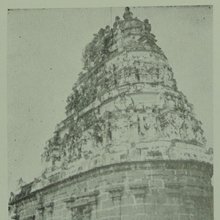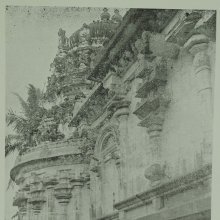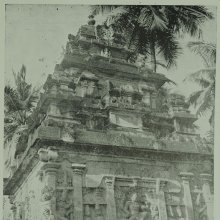Vimana, Vimāna: 40 definitions
Introduction:
Vimana means something in Buddhism, Pali, Hinduism, Sanskrit, Jainism, Prakrit, the history of ancient India, Marathi, Hindi. If you want to know the exact meaning, history, etymology or English translation of this term then check out the descriptions on this page. Add your comment or reference to a book if you want to contribute to this summary article.
Images (photo gallery)
(+11 more images available)
In Hinduism
Vastushastra (architecture)
Source: Wisdom Library: Vāstu-śāstra1) Vimāna (विमान).—Vimānas represent the ‘aerial chariots’ of the gods, but also refers to seven-storey palaces. According to the 11th-century Samarāṅgaṇasūtradhāra (chapter 49), long ago Brahmā created five prime Vimānas for gods:
- Vairāja for Brahmā himself,
- Kailāśa for Śiva,
- Puṣpaka for Kubera,
- Maṇika for Varuṇa,
- Triviṣṭapa for Viṣṇu,
Like these he created so many other Vimānas meant for the use of other gods such as Sūrya, etc.—having of course the shapes etc. in the likeness with those of the deities using them. It is from the self-same five shapes of Vimānas that later on, Brahmā created the Prāsāda. They are to be built in towns and are made of stone or burnt bricks.
2) Vimāna (विमान) refers to a type of temple (prāsāda) classified under the group named Vairāja, according to Samarāṅgaṇasūtradhāra chapter 49. The Vairāja group contains twenty-four out of a sixty-four total prāsādas (temples) classified under five prime vimānas (aerial car/palace), which were created by Brahmā for as many gods (including himself). The group represents temples (e.g. Vimāna) that are to be square shaped. The prāsādas, or ‘temples’, represent the dwelling place of God and are to be built in towns. The Samarāṅgaṇasūtradhāra is an 11th-century encyclopedia dealing with various topics from the Vāstuśāstra.
Vimāna is also listed in the Agnipurāṇa which features a list of 45 temple types. It is listed under the group named Vairāja, featuring square-shaped temples. This list represents a classification of temples in Nort-India.
3) Vimāna can also refer to a “residence” in general, according to the lists of synonyms given in the Mayamata XIX.10-12 and the Mānasāra XIX.108-12, both populair treatises on Vāstuśāstra.
4) Vimāna can also refer to the tower above the main shrine (consisting of six parts, ṣaḍvarga).
Source: Shodhganga: Development of temple architecture in Southern KarnatakaThe definition of vimāna, according to the Texts, is that part of the structure starting from upāna, the lowest member of the plinth to the stūpi, i.e., the finial of the structure. Upāna is the mo ulding found throughout the temple building. But the stūpi is found only at the apex of the tower abo ve the sanctum. Therefore, the definition applies to the sanctum part only, but the tower abo ve the sa nctum is al so called by the name vimāna.
Source: Digital Library of India: Bharatiya Vastu-sastra volume 1Vimāna (विमान):—The common word denoting the ‘temple’ is Vimāna (dwelling of God), in practically all the manuals on architecture e.g., in the Mānasāra, buildings of one to twelve storeys are called Vimānas (XVIII). There is a great metaphysical or more correctly a cosmological truth embedded in this word.
The Vāyu-purāṇa (IV.30-31) says:—“To measure (mā) is to make a thing by giving shape to it and existence”. Vimāna, therefore, measured in its parts, is the form of God, which is this Universe, the macrocosm, and the temple the microcosm. To measure, as the Samarāṅgaṇa-sūtradhāra has aptly said, is to create—there is an idntity between the measure and the object. Whatever is produced is called meya.
Dr. Kramrisch has very beautifully brought out the significance of the word denoting and connoting temple both in its architectural and spiritual implications—“The temple as Vimāna, proportionately measured throughout, is the house and body of God. By temple is understood the main shrine only in which is contained the Garbhagṛha, the womb and house of the Embryo, the small, innermost sanctuary with its generally square plan.”
Source: Shodhganga: Temples of Salem region Up to 1336 ADVimāna (विमान).—The definition of vimāna according to the Texts is that part of the structure starting from upāna, the lowest member of the plinth (adhiṣṭhāna), to the stūpi i.e. the finial of the structure. According to the texts, the temple should consist of six main parts (ṣaḍvarga) in the elevation. They are adhiṣṭhāna, bhitti, prastara, grīva, śikhara and stūpi. The Texts refer to this part as vimāna. In this ṣaḍvarga, tower consisting of tiers is not included. The tower is then an optional member. Therefore the use of the term vimāna for the tower above is ambiguous. It may refer to the main shrine or to the tower above it.
Source: Knowledge Traditions & Practices of India: Architecture (1): Early and Classical ArchitectureVimāna (विमान, “tower”) refers to a common concept found in the ancient Indian “science of architecture” (vāstuvidyā).—Śikhara (for north Indian temples) or vimāna (for south Indian temple) is the tower over the garbhagṛha.
Source: OpenEdition books: Architectural terms contained in Ajitāgama and RauravāgamaVimāna (विमान) refers to “temple §§ 1.8; 4.2.”.—(For paragraphs cf. Les enseignements architecturaux de l'Ajitāgama et du Rauravāgama by Bruno Dagens)
Source: Shodhganga: Elements of Art and Architecture in the Trtiyakhanda of the Visnudharmottarapurana (vastu)Vimāna (विमान) refers to a “seven-storied” variety of the hundred types of Temples (in ancient Indian architecture), according to the Viṣṇudharmottarapurāṇa, an ancient Sanskrit text which (being encyclopedic in nature) deals with a variety of cultural topics such as arts, architecture, music, grammar and astronomy.—It is quite difficult to say about a definite number of varieties of Hindu temples but in the Viṣṇudharmottarapurāṇa hundred varieties of temples have been enumerated. For example, Vimāna. These temples are classified according to the particular shape, amount of storeys and other common elements, such as the number of pavilions, doors and roofs.

Vastushastra (वास्तुशास्त्र, vāstuśāstra) refers to the ancient Indian science (shastra) of architecture (vastu), dealing with topics such architecture, sculpture, town-building, fort building and various other constructions. Vastu also deals with the philosophy of the architectural relation with the cosmic universe.
Purana and Itihasa (epic history)
Source: archive.org: Shiva Purana - English Translation1) Vimāna (विमान) refers to a “chariot-like structure”, as explained in the Śivapurāṇa 1.11. Accordingly, as Sūta explains the mode of worshipping the phallic form of Śiva: “A vimāna (chariot-like structure) of artistic beauty shall be made at first wherein the divine attendants shall be represented. In its firm and beautiful sanctum sanctorum shining like a mirror studded with the nine precious gems—sapphire, lapis lazuli, Emerald, pearl, coral, gomedaka, diamonds and rubies, the emblem shall be installed on the altar”.
2) Vimāna (विमान) [=vimānaka?] refers to the “palaces (of a city)”, according to the Śivapurāṇa 2.3.31 (“Description of Śiva’s magic”).—Accordingly, as the Seven Sages said amongst each other (when arriving at Himavatpura city): “[...] The splendour of festoons is also seen in every house. They are of different colours and sorts with shapes of parrots and swans carved on the walls of the palaces (vimānaka—śukahaṃsairvimānakaiḥ). The canopies with hanging festoons are of diverse character. There are many lakes and ponds. The gardens and parks are of various kinds frequented by delighted people. Here men are like gods and the women are like the celestial damsels. [...]”.
Source: Cologne Digital Sanskrit Dictionaries: The Purana Index1a) Vimāna (विमान).—A temple with eight floors and a number of towers; the toraṇa is of 34 hastas.*
- * Matsya-purāṇa 269. 28, 32, 47.
1b) Indra took Ditī and the Maruts in it to heaven;1 Vivasvān took Samjñā with him.2
1c) Vehicles of gods;1 built by Viśvakarma.2
- 1) Vāyu-purāṇa 30. 96.
- 2) Brahmāṇḍa-purāṇa III. 10. 119; 16. 14 and 51; 59. 18; IV. 17. 16; Vāyu-purāṇa 66. 30.

The Purana (पुराण, purāṇas) refers to Sanskrit literature preserving ancient India’s vast cultural history, including historical legends, religious ceremonies, various arts and sciences. The eighteen mahapuranas total over 400,000 shlokas (metrical couplets) and date to at least several centuries BCE.
Natyashastra (theatrics and dramaturgy)
Source: Wisdom Library: Nāṭya-śāstraVimāna (विमान) refers to the “celestial car”; it is a Sanskrit technical term defined in the Nāṭyaśāstra.

Natyashastra (नाट्यशास्त्र, nāṭyaśāstra) refers to both the ancient Indian tradition (shastra) of performing arts, (natya—theatrics, drama, dance, music), as well as the name of a Sanskrit work dealing with these subjects. It also teaches the rules for composing Dramatic plays (nataka), construction and performance of Theater, and Poetic works (kavya).
Shilpashastra (iconography)
Source: Shodhganga: The significance of the mūla-beras (śilpa)Vimāna (विमान) refers to the “towered sanctuary” of the Hindu temple.—The temple contains the sanctuary known as vimāna or towered sanctuary. Over the vimāna is the śikhara or the spire/tower. The topmost part of the śikhara, whose sloping walls lead towards a point, is the stūpi or the finial or the apex.

Shilpashastra (शिल्पशास्त्र, śilpaśāstra) represents the ancient Indian science (shastra) of creative arts (shilpa) such as sculpture, iconography and painting. Closely related to Vastushastra (architecture), they often share the same literature.
Kavya (poetry)
Source: archive.org: Naisadhacarita of SriharsaVimāna (विमान) refers to an “open palanquin carried on men’s shoulders”, and is mentioned in the Naiṣadha-carita 10.107.—Cf. Vimānavāha (verse 11.23); Vimānadhurya (verse 13.1) both “palanquin bearers”. It should be noted that vimāna does not mean here “an aerial car”. In the above sense, vimāna is the same as karṇiratha. Cf. Appayadīkṣita in his commentary on Yādavābhyudaya 12.88. [...] In Jayantavijaya 13.77, 79 the bridegroom comes to the bride’s place in a vimāna.

Kavya (काव्य, kavya) refers to Sanskrit poetry, a popular ancient Indian tradition of literature. There have been many Sanskrit poets over the ages, hailing from ancient India and beyond. This topic includes mahakavya, or ‘epic poetry’ and natya, or ‘dramatic poetry’.
Ayurveda (science of life)
Veterinary Medicine (The study and treatment of Animals)
Source: Shodhganga: Portrayal of Animal Kingdom (Tiryaks) in Epics An Analytical studyVimāna (विमान) (lit. “one who is devoid of honour”) is a synonym (another name) for the Horse (Aśva), according to scientific texts such as the Mṛgapakṣiśāstra (Mriga-pakshi-shastra) or “the ancient Indian science of animals and birds” by Hamsadeva, containing the varieties and descriptions of the animals and birds seen in the Sanskrit Epics such as the Ramayana and Mahabharata.
Source: Asian Agri-History: Paśu Āyurvēda (Veterinary Medicine) in GaruḍapurāṇaVimana (विमन) refers to “diminutive in size” representing one of various undesirable characteristics in horses (haya/aśva), according to Āyurveda sections in the Garuḍapurāṇa.—The treatment pertains to horses was described in detail in Garuḍapuraāṇa Ācārakhaṇḍa the chapter entitled Gajāśvāyurveda.There are many types of horses but the horse, which does not possess one of the various features [e.g., Vimana (diminutive in size)], is considered as healthy and fit one. Such type of horses only useful for riding, wars and other purposes.

Āyurveda (आयुर्वेद, ayurveda) is a branch of Indian science dealing with medicine, herbalism, taxology, anatomy, surgery, alchemy and related topics. Traditional practice of Āyurveda in ancient India dates back to at least the first millenium BC. Literature is commonly written in Sanskrit using various poetic metres.
Shaktism (Shakta philosophy)
Source: Google Books: ManthanabhairavatantramVimāna (विमान) refers to a “vehicle”, according to the Ṣaṭsāhasrasaṃhitā, an expansion of the Kubjikāmatatantra: the earliest popular and most authoritative Tantra of the Kubjikā cult.—Accordingly, “[...] O mistress of the gods, the human flesh comes from the Creeper (latā), the Vine (vallī), and the Vehicle (vimāna). One should know that (the flesh of one) who has died by being dragged along (the ground) by bulls is called the Creeper. The Vine (is human flesh) that has been extracted (from a human corpse). The Vehicle (is the flesh of one) who has been torn apart by a spear (śūla). (These three are, respectively,) the inferior, middling and the best. [...]”.

Shakta (शाक्त, śākta) or Shaktism (śāktism) represents a tradition of Hinduism where the Goddess (Devi) is revered and worshipped. Shakta literature includes a range of scriptures, including various Agamas and Tantras, although its roots may be traced back to the Vedas.
Shaivism (Shaiva philosophy)
Source: SOAS University of London: Protective Rites in the Netra TantraVimāna (विमान) refers to a “chariot”, according to the Svacchanda-tantra.—Accordingly, [verse 4.8-13, while describing auspicious dreams]—“[The dreamer] crosses over the ocean and river. Likewise sunrise and indeed blazing fire [are auspicious. Also auspicious is when the dreamer] sees planets, constellations, stars and the disk of the moon. [When the dreamer] ascends the palace or a turret of the palace, climbs a mountain top, tree, elephant, young animal, bull, horse, or man. [In auspicious dreams one] sees a chariot (vimāna-gamana) and also sees the siddhamantra, obtains the perfected oblation and sees the gods, etc. [...]”

Shaiva (शैव, śaiva) or Shaivism (śaivism) represents a tradition of Hinduism worshiping Shiva as the supreme being. Closely related to Shaktism, Shaiva literature includes a range of scriptures, including Tantras, while the root of this tradition may be traced back to the ancient Vedas.
General definition (in Hinduism)
Source: Academia.edu: Prāsāda as PalaceVimāna (विमान) used in South India for the temple, refers as well to the portable “car” in which the image is taken in procession.
In Buddhism
Mahayana (major branch of Buddhism)
Source: academia.edu: A Study and Translation of the GaganagañjaparipṛcchāVimāna (विमान) refers to a “celestial palace”, according to the Gaganagañjaparipṛcchā: the eighth chapter of the Mahāsaṃnipāta (a collection of Mahāyāna Buddhist Sūtras).—Accordingly, as the Lord said to the Bodhisattva Ratnaśrī: “[...] That Kāyabandhana universe was, son of good family, thriving, prosperous, safe, well-provided, filled with a great multitude of men, adorned with seven precious jewels, peaceful and delightful, pleasant to touch like a soft cloth, displayed by the lotus of gold from the Jāmbū river, decorated with all kinds of luminous jewels, patterned like a chess-board, and even like the palm of the hand. Just like the enjoyment and entertainment of the Paranirmitavaśavartin gods, all the people in that universe, staying in celestial palace (vimāna) and pavilions, enjoyed food and drink as they wished”.
Source: De Gruyter: A Buddhist Ritual Manual on AgricultureVimāna (विमान) refers to a “flying palace” as occurring in the Heart-mantra (hṛdayamantra) taught to Vajrapāṇi, according to the Vajratuṇḍasamayakalparāja, an ancient Buddhist ritual manual on agriculture from the 5th-century (or earlier), containing various instructions for the Sangha to provide agriculture-related services to laypeople including rain-making, weather control and crop protection.

Mahayana (महायान, mahāyāna) is a major branch of Buddhism focusing on the path of a Bodhisattva (spiritual aspirants/ enlightened beings). Extant literature is vast and primarely composed in the Sanskrit language. There are many sūtras of which some of the earliest are the various Prajñāpāramitā sūtras.
In Jainism
General definition (in Jainism)
Source: archive.org: TrisastisalakapurusacaritraVimāna (विमान) refers to the “aerial car” of Śakra (Indra), according to chapter 1.2 [ādīśvara-caritra] of Hemacandra’s 11th century Triṣaṣṭiśalākāpuruṣacaritra: an ancient Sanskrit epic poem narrating the history and legends of sixty-three illustrious persons in Jainism.
Accordingly,
Source: Encyclopedia of Jainism: Tattvartha Sutra 4: The celestial beings (deva)“Pālaka, observing the Lord’s command, made a car [i.e., vimāna] that filled the sky with a flood of light from a thousand jeweled pillars; having eyes, as it were, in the form of windows; having teeth, as it were, in the form of balconies; having horripilation, as it were, in the form of finials; five hundred yojanas high and a hundred thousand square, moving from the inference of a wish.
[...] Then surrounded by Sāmānikas and other gods, Śakra looked like the ocean with a crore of rivers. His aerial car [i.e., vimāna], surrounded by the aerial cars of the other gods, looked just like the principal shrine with shrines in an outer circle. The aerial cars, reflected in each other’s beautiful jeweled walls, shone as if filled with (other) aerial cars. [...]
[...] The car [i.e., vimāna] with its great flag, descending from the surface of the sky, looked like a ship descending from the crest in the middle of the ocean. Inside the constellation-circle, like an elephant inside a group of trees, making the sky seem to be covered with clouds, as it were, after crossing numberless continents and oceans, like the wind in speed, the car arrived at Nandīśvaradvīpa. Going to Mt. Ratikara in the southeast, Indra contracted the car, like a learned man abridging a book. Then, after crossing continents and oceans on this side, gradually contracting the car more and more, Vāsava arrived at the continent named Jambūdvīpa, at the southern half of Bharata, and at the birth-house of the first Tīrthakṛt”.
Vimāna (विमान, “heavenly abode”) refers to the residence of the empyrean gods (vaimānika), according to the 2nd-century Tattvārthasūtra 4.16. The abodes, which make the beings residing in them feel as possessing merit are called vimāna. The living beings residing in them are called the empyrean gods. How many types of heavenly abodes (vimāna) are there? They are of three types namely: Indra, Śreṇībaddha and Prakīrṇaka.
Source: The University of Sydney: A study of the Twelve ReflectionsVimāna (विमान) refers to the “celestial vehicles”, according to the 11th century Jñānārṇava, a treatise on Jain Yoga in roughly 2200 Sanskrit verses composed by Śubhacandra.—Accordingly, “And, having obtained the good fortune of heaven, [those corporeal beings] enjoy heavenly pleasure in the lower heavens and in the celestial vehicles (vimāna) or among other groups [of gods]. They fall from that place [and] immediately they enter the Rasātala hell. They roam about the whole world like the wind [and] they fall down into the Naraka hell”.

Jainism is an Indian religion of Dharma whose doctrine revolves around harmlessness (ahimsa) towards every living being. The two major branches (Digambara and Svetambara) of Jainism stimulate self-control (or, shramana, ‘self-reliance’) and spiritual development through a path of peace for the soul to progess to the ultimate goal.
India history and geography
Source: Cologne Digital Sanskrit Dictionaries: Indian Epigraphical GlossaryVimāna.—(SITI), the pinnacle or upper structure over the sanctum of a temple; the central shrine of a temple (SII 3); also called śrī-vimāna (SII 13); same as garbha-gṛha. (EI 3, 23), a shrine. (IA 9), the steeple tower over a shrine; also called stupī. Note: vimāna is defined in the “Indian epigraphical glossary” as it can be found on ancient inscriptions commonly written in Sanskrit, Prakrit or Dravidian languages.
Source: Singhi Jain Series: Ratnaprabha-suri’s Kuvalayamala-katha (history)Vimāna (विमान) refers to the temple-complex of ancient India, as vividly depicted in the Kathās (narrative poems) such as Uddyotanasūri in his 8th-century Kuvalayamālā (a Prakrit Campū, similar to Kāvya poetry).—Page 92.24-31: A Devī-vimāna is described as being decorated with rubies, pearls-pendants and festoons, rows of bells attached to banners, rows of vaijayantī flags fixed on the top, lotus-medallions formed by the inset work of rubies, figures of the lotus-pond and thus giving appearance of Padma-vimāna. Such was the external appearance of vimāna but in its middle portion or inside there were living apartments with rooms or retiring chambers beautified all-round with pearl-festoons furnished with a bed spread of chalcedony and blue stone, foot-stool of emerald, placed on a floor of precious stones and furnished above with a devāṅga cloth and upper canopy like devadūṣya cloth.
Source: Heidelberg: Glory of the Tiruvanantapuram Padmanabhasvami TempleVimāna (विमान) refers to the “towers on top of the sanctum” of Hindu temples, according to the Syānandūrapuravarṇana-prabandha by Svāti-Tirunāḷ (1813-1846) (one of the rulers of Travancore) which deals with the different activities of the Thiruvananthapuram Temple, including ceremonies and festivals.—[...] The fifth chapter also gives a detailed sketch of the temple and its components, such as the balipīṭha (pedestal for food offerings) (5.8), various maṇḍapas (pillared halls) (5.9–10), vimānas (towers on top of the sanctum) (5.10), the single stone maṇḍapa (5.11), the dhvajastambha (flag-post) (5.12–14), the gopura (towers at the entrances) (5.14–15), the kulaśekharamaṇḍapa (5.15), etc.

The history of India traces the identification of countries, villages, towns and other regions of India, as well as mythology, zoology, royal dynasties, rulers, tribes, local festivities and traditions and regional languages. Ancient India enjoyed religious freedom and encourages the path of Dharma, a concept common to Buddhism, Hinduism, and Jainism.
Languages of India and abroad
Pali-English dictionary
Source: BuddhaSasana: Concise Pali-English Dictionaryvimana : (adj.) displeased; distracted. || vimāna (nt.) a mansion; heavenly palace.
Source: Sutta: The Pali Text Society's Pali-English Dictionary1) Vimana, (adj.) (vi+mano) 1. perplexed, consternated Miln. 23, 118; PvA. 274.—2. infatuate Th. 2, 380. ‹-› 3. distracted, distressed Th. 1, 1051; J. VI, 523. (Page 630)
2) Vimāna, 2 (vi+māna) disrespect, contempt Sn. 887 (°dassin showing contempt). (Page 632)
3) Vimāna, 1 (nt.) (in the Pāli meaning not Vedic. Found in meaning “palace-chariot” in the Mbhārata and elsewhere in Epic Sk. ) lit. covering a certain space, measuring; the definitions given by Dhpāla refer it to “without measure, ” i.e. immeasurable. Thus=vigata-māne appamāṇe mahanta vara-pāsāda VvA. 131; =visiṭṭhamānaṃ, pamāṇato mahantaṃ VvA. 160.—applied meaning: heavenly (magic) palace, a kind of paradise, elysium.
General remarks: The notion of the vimāna is peculiar to the later, fantastic parts of the Canon, based on popular superstition (Vimāna & Peta Vatthu, Apadāna, Jātaka and similar fairy tales). It shows distinct traces of foreign (Hellenic-Babylonian) influence and rests partly on tales of sea-faring merchants (cp. location of V. in mid-ocean). On the other hand it represents the old (Vedic) ratha as chariot of the gods, to be driven at will (cp. below 5, 7, 8). Thus at Vv 16 (here as 500 chariots!), 36, 63, 64; J. I, 59 (deva-vimānasadisa ratha).
Also see the article Vimāna.

Pali is the language of the Tipiṭaka, which is the sacred canon of Theravāda Buddhism and contains much of the Buddha’s speech. Closeley related to Sanskrit, both languages are used interchangeably between religions.
Marathi-English dictionary
Source: DDSA: The Molesworth Marathi and English Dictionaryvimāna (विमान).—n (S) A chariot of the gods, serving as a throne or as a conveyance through the skies, self-directed and self-moving.
Source: DDSA: The Aryabhusan school dictionary, Marathi-Englishvimanā (विमना).—a Sad. Perplexed. Of estranged mind.
--- OR ---
vimāna (विमान).—n A balloon.
Marathi is an Indo-European language having over 70 million native speakers people in (predominantly) Maharashtra India. Marathi, like many other Indo-Aryan languages, evolved from early forms of Prakrit, which itself is a subset of Sanskrit, one of the most ancient languages of the world.
Sanskrit dictionary
Source: DDSA: The practical Sanskrit-English dictionaryVimāna (विमान).—a. Disgraced, devoid of honour; तन्मक्षिकाभिर्व्यथितो विमानः (tanmakṣikābhirvyathito vimānaḥ) Bhāgavata 5.13.1.
--- OR ---
Vimāna (विमान).—
1) Disrespect, dishonour; आक्रोशनविमानाभ्यां नाबुधान् बोधयेद् बुधः (ākrośanavimānābhyāṃ nābudhān bodhayed budhaḥ) Mahābhārata (Bombay) 12.299.25; Bhāgavata 5. 1.25.
2) A measure.
3) A balloon, a heavenly car (moving through the skies); पदं विमानेन विगाहमानः (padaṃ vimānena vigāhamānaḥ) R. 13.1;7.51; विमानीकृतराजहंसमण्डलः (vimānīkṛtarājahaṃsamaṇḍalaḥ) K.; R.12.14; Ku. 2.45;7.4; V.4.43; Kirātārjunīya 7.11; विगते दिवसे ततो विमानं वपुषा सूर्य इव प्रदीप्यमानः (vigate divase tato vimānaṃ vapuṣā sūrya iva pradīpyamānaḥ) (āruroha) Bu. Ch.5.43.
4) A vehicle or conveyance in general; स नौविमानादवतीर्य रेमे (sa nauvimānādavatīrya reme) R.16.68.
5) A palace (with seven stories); 'विमानोऽस्त्री देवयाने सप्तभूमौ च सद्मनि (vimāno'strī devayāne saptabhūmau ca sadmani)' इति निघण्टुः (iti nighaṇṭuḥ); Rām.1.5.16; नेत्रा नीताः सततगतिना यद्विमानाग्रभूमीः (netrā nītāḥ satatagatinā yadvimānāgrabhūmīḥ) Meghadūta 71.
7) A horse.
8) An open palanquin carried on men's shoulders; इमां विमानेन सभां विशन्तीं पपावपाङ्गैरथ राजराजिः (imāṃ vimānena sabhāṃ viśantīṃ papāvapāṅgairatha rājarājiḥ) N.1.17.
9) A ship, boat.
Derivable forms: vimānaḥ (विमानः), vimānam (विमानम्).
Source: Cologne Digital Sanskrit Dictionaries: Shabda-Sagara Sanskrit-English DictionaryVimāna (विमान).—mn.
(-naḥ-naṃ) 1. A car or chariot of the gods, sometimes serving as a seat or throne, and at others carrying them through the skies self-directed and self-moving; hence it also applies to the sky. 2. Any car or vehicle. 3. A horse. 4. A palace, the palace of an emperor, or supreme monarch. 5. A seven-storied palace. 6. Disrespect, dishonour. 7. Measure. E. vi before man to understand, with ghañ aff.; or mā to measure, aff. lyuṭ; to vi priv., māna honour.
Source: Cologne Digital Sanskrit Dictionaries: Benfey Sanskrit-English DictionaryVimāna (विमान).—[vi-māna], m. and n. 1. A chariot of the gods, [Vikramorvaśī, (ed. Bollensen.)] 4, 1; [Rāmāyaṇa] 3, 48, 6. 2. Any vehicle, [Rāmāyaṇa] 3, 54, 6. 3. A horse. 4. A palace, [Meghadūta, (ed. Gildemeister.)] 64. 5. (vi-mā + ana), A measure.
Source: Cologne Digital Sanskrit Dictionaries: Cappeller Sanskrit-English DictionaryVimāna (विमान).—1. [feminine] ī measuring, traversing, pervading, [especially] the sky.
— [masculine] [neuter] sky-chariot (of gods etc.), waggon i.[grammar]; palace, tower; [neuter] extension, measure.
--- OR ---
Vimāna (विमान).—2. [masculine] despising, contempt.
--- OR ---
Vimāna (विमान).—3. [adjective] dishonoured.
Source: Cologne Digital Sanskrit Dictionaries: Monier-Williams Sanskrit-English Dictionary1) Vimana (विमन):—[=vi-mana] [from vi] mfn. (mc.) = vi-manas, dejected, downcast, [Rāmāyaṇa]
2) Vimāna (विमान):—[=vi-māna] [from vi] a mfn. (for 2. See vi-√man) devoid of honour, disgraced, [Bhāgavata-purāṇa]
3) [=vi-māna] [from vi-man] 2. vi-māna m. (for 1. See p. 951, col. 3; for 3. under vi-√mā) disrespect, dishonour (See a-vi mana).
4) [=vi-māna] [from vi-mā] 3. vi-māna mf(ī)n. (for 1. See p. 951, col. 3; for 2, under vi-√man) measuring out, traversing, [Ṛg-veda; Atharva-veda; Mahābhārata]
5) [v.s. ...] m. n. a car or chariot of the gods, any mythical self-moving aerial car (sometimes serving as a seat or throne, sometimes self-moving and carrying its occupant through the air; other descriptions make the Vimāna more like a house or palace, and one kind is said to be 7 stories high; that of Rāvaṇa was called puṣpaka q.v.; the nau-v [Raghuvaṃśa xvi, 68] is thought to resemble a ship), [Mahābhārata; Kāvya literature] etc.
6) [v.s. ...] m. any car or vehicle ([especially] a bier), [Rājataraṅgiṇī vii, 446]
7) [v.s. ...] the palace of an emperor or supreme monarch ([especially] one with 7 stories), [Mahābhārata; Kāvya literature] etc.
8) [v.s. ...] a temple or shrine of a [particular] form, [Varāha-mihira’s Bṛhat-saṃhitā]
9) [v.s. ...] a kind of tower (?), [Rāmāyaṇa v, 52, 8]
10) [v.s. ...] a grove, [Jātakamālā]
11) [v.s. ...] a ship, boat, [cf. Lexicographers, esp. such as amarasiṃha, halāyudha, hemacandra, etc.]
12) [v.s. ...] a horse, [cf. Lexicographers, esp. such as amarasiṃha, halāyudha, hemacandra, etc.]
13) [v.s. ...] n. measure, [Ṛg-veda]
14) [v.s. ...] extension, [ib.]
15) [v.s. ...] (in med.) the science of (right) measure or proportion (e.g. of the right relation between the humours of the body, of medicines and remedies etc.), [Caraka]
Source: Cologne Digital Sanskrit Dictionaries: Yates Sanskrit-English DictionaryVimāna (विमान):—[vi-māna] (naḥ-naṃ) 1. m. n. A car of the gods; a car, a horse; a place; disrespect. a. Dishonoured.
Source: DDSA: Paia-sadda-mahannavo; a comprehensive Prakrit Hindi dictionary (S)Vimāna (विमान) in the Sanskrit language is related to the Prakrit word: Vimāṇa.
[Sanskrit to German]
Sanskrit, also spelled संस्कृतम् (saṃskṛtam), is an ancient language of India commonly seen as the grandmother of the Indo-European language family (even English!). Closely allied with Prakrit and Pali, Sanskrit is more exhaustive in both grammar and terms and has the most extensive collection of literature in the world, greatly surpassing its sister-languages Greek and Latin.
Hindi dictionary
Source: DDSA: A practical Hindi-English dictionary1) Vimana (विमन) [Also spelled viman]:—(a) downcast, dejected, out of sorts.
2) Vimāna (विमान) [Also spelled viman]:—(nm) an aeroplane, aircraft, airliner; -[kṣetra] airfield; aerodrome; -[cālana] aviation; -[cālaka] a pilot; ~[na] aviation; -[pattana] airport; -[paricārikā] airhostess; ~[vāhaka] aircraft-carrier; ~[vāhita] airborne; -[vijñāna] aeronautics; ~[vaijñānika] aeronautical.
...
Prakrit-English dictionary
Source: DDSA: Paia-sadda-mahannavo; a comprehensive Prakrit Hindi dictionary1) Vimaṇa (विमण) in the Prakrit language is related to the Sanskrit word: Vimanasa.
2) Vimāṇa (विमाण) also relates to the Sanskrit word: Vimāna.
3) Vimāṇa (विमाण) also relates to the Sanskrit word: Vimāna.
Prakrit is an ancient language closely associated with both Pali and Sanskrit. Jain literature is often composed in this language or sub-dialects, such as the Agamas and their commentaries which are written in Ardhamagadhi and Maharashtri Prakrit. The earliest extant texts can be dated to as early as the 4th century BCE although core portions might be older.
Kannada-English dictionary
Source: Alar: Kannada-English corpusVimana (ವಿಮನ):—
1) [noun] a sad, depressed man.
2) [noun] a man who is confused or bewildered.
3) [noun] a wicked, evil-minded man.
--- OR ---
Vimāna (ವಿಮಾನ):—
1) [noun] loss of one’s prestige, regard; slight to one’s dignity.
2) [noun] a shameless, immodest, impudent or indecent fellow.
3) [noun] the act of measuring (using a standard unit).
4) [noun] any mythical, self-moving aerial car or chariot of gods.
5) [noun] a heavier-than-air aircraft kept aloft by the upward thrust exerted by the passing air on its fixed wings and driven by propellers, jet propulsion, etc.; an airplane.
6) [noun] the residence of a king or monarch; a palace.
7) [noun] (gen.) any building including residential buildings, temple buildings, etc.
8) [noun] the tower of a temple.
9) [noun] a light bamboo structure made for carrying a dead-body.
10) [noun] a covered litter for carrying a person on the shoulders of two or more men.
11) [noun] (jain.) the abode in the heavens for the virtuous persons, after their departure from this world.
Kannada is a Dravidian language (as opposed to the Indo-European language family) mainly spoken in the southwestern region of India.
See also (Relevant definitions)
Starts with (+42): Vimaanayuddh, Vimana Vatthu, Vimanaapaharana, Vimanabhedi, Vimanacakravartin, Vimanacarin, Vimanacarini, Vimanacchanda, Vimanachakravartin, Vimanacharin, Vimanacharini, Vimanachchhanda, Vimanacyuta, Vimanadharani, Vimanadhurya, Vimanagamana, Vimanagamin, Vimanaghata, Vimanajhyala, Vimanaka.
Ends with (+22): Abhivimana, Agariya Vimana, Akashavimana, Anekavannavimana, Aranavimana, Avimana, Brahmavimana, Camdravimana, Caturitthi Vimana, Chattavimana, Dasivimana, Devavimana, Devivimana, Dvarapalaka Vimana, Hamsavimana, Kanakavimana, Kanikara Vimana, Karaniyavimana, Mahavimana, Manithunavimana.
Full-text (+369): Vimanas, Vimanaska, Pushpaka, Stupi, Vaimanika, Vimanastha, Vimanata, Abhivimana, Vimanayana, Udvedi, Vimanaka, Vaimanasya, Kamagati, Vibhutamanas, Avimana, Vimanita, Vimanana, Vimanavidya, Vimanalakshana, Vimananirvyuha.
Relevant text
Search found 83 books and stories containing Vimana, Vi-māna, Vi-mana, Vimāna, Vimāṇa, Vimaṇa, Vimanā; (plurals include: Vimanas, mānas, manas, Vimānas, Vimāṇas, Vimaṇas, Vimanās). You can also click to the full overview containing English textual excerpts. Below are direct links for the most relevant articles:
Vastu-shastra (5): Temple Architecture (by D. N. Shukla)
Bhaumika Vimānas (Temples of South India, Decan and Greater India) < [Chapter 12 - History of Hindu Temples (Prāsādas and Vimānas)]
Bhagavati-sutra (Viyaha-pannatti) (by K. C. Lalwani)
Part 1 - On cells in the hells < [Chapter 5]
Chapter 5: On birds < [Book 7]
Part 3 - Lokāntika devas < [Chapter 5]
Rig Veda (translation and commentary) (by H. H. Wilson)
Brihad Bhagavatamrita (commentary) (by Śrī Śrīmad Bhaktivedānta Nārāyana Gosvāmī Mahārāja)
Verse 2.4.12 < [Chapter 4 - Vaikuṇṭha (the spiritual world)]
Verse 2.2.12 < [Chapter 2 - Jñāna (knowledge)]
Verse 2.4.48 < [Chapter 4 - Vaikuṇṭha (the spiritual world)]
Early Chola Temples (by S. R. Balasubrahmanyam)
Parantaka I < [Chapter XIV - Conclusion]
Sikhara < [Chapter XIII - Prasada: Component Parts]
Related products







